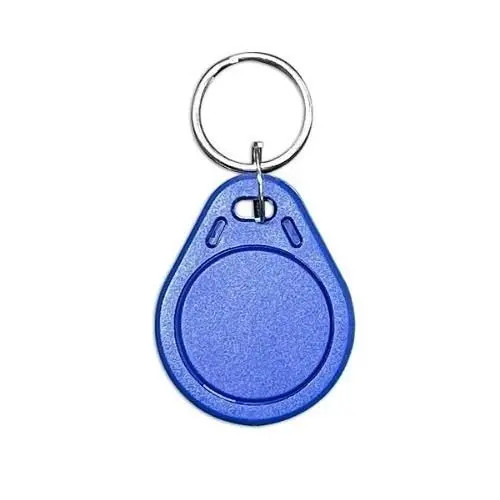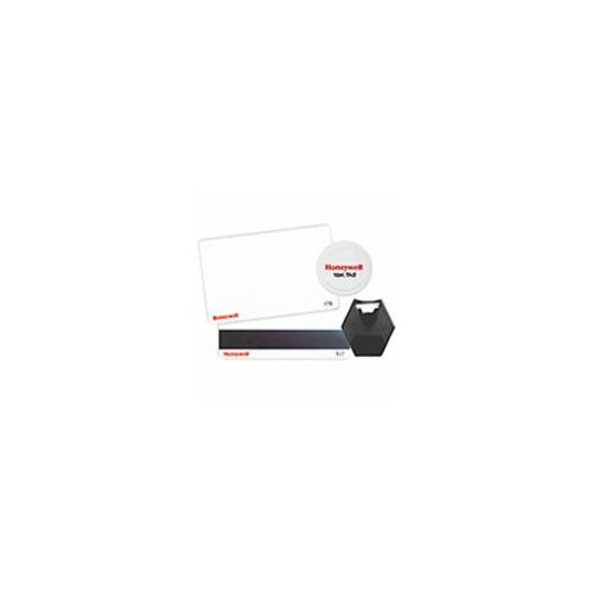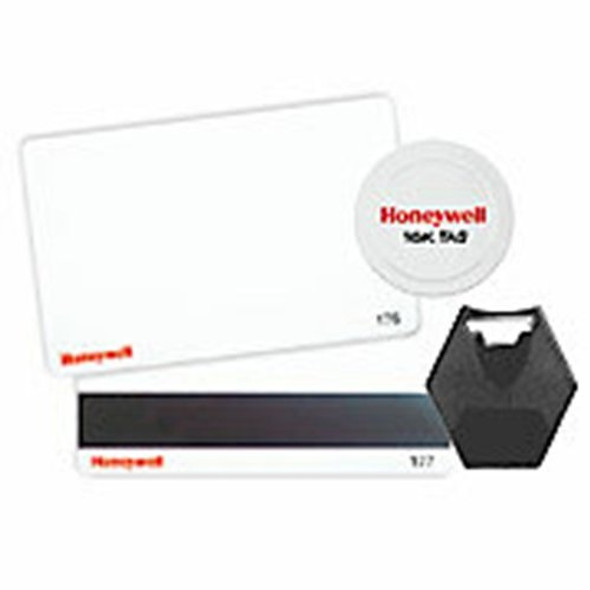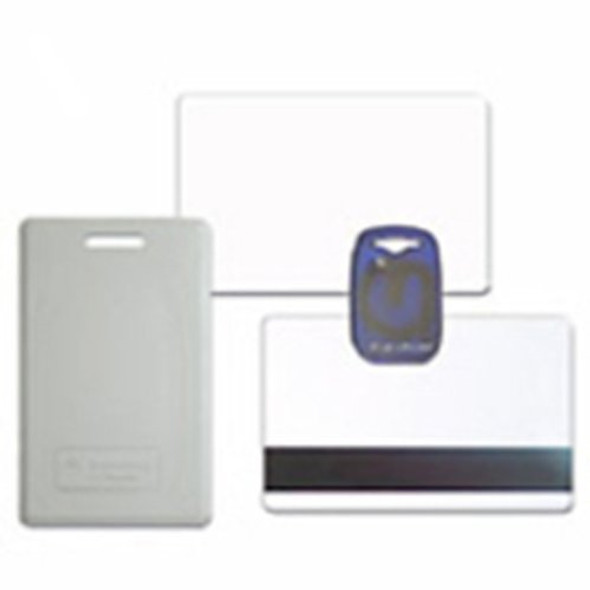Cards & Card Readers
Card readers are not just for debit and credit cards but are some of the best examples of hardware for access control. Unlike those traditionally recognized for transactions, these cards and card readers are either proximity or magnetic based. Furthermore, they prove easily effective when integrated with a more extensive security system with surveillance and alarms. As a result, companies with cards and card readers can efficiently conduct business on a daily basis and never worry about unauthorized individuals accessing areas you want to be restricted.
Key features of Access Control Card and Card Readers
- Card Recognition Technology: Utilizes RFID (Radio Frequency Identification) or other technologies to read and recognize access control cards.
- Card Types Compatibility: Supports various types of access control cards, including proximity cards, smart cards, and magnetic stripe cards.
- Authentication Protocols: Implements authentication protocols to verify the legitimacy of access cards and ensure secure entry.
- Biometric Integration: Some advanced card readers integrate biometric authentication methods (such as fingerprint or retina scanning) for enhanced security.
- Multi-Format Support: Compatible with multiple card formats and standards to accommodate different security systems and technologies.
- Communication Protocols: Communicates with access control systems through protocols like Wiegand, RS-485, or TCP/IP for seamless integration.
- Tamper Detection: Equipped with tamper detection features to alert security personnel in case of unauthorized attempts to manipulate or disable the card reader.
- Weather Resistance: Designed to withstand various environmental conditions, including moisture and extreme temperatures, for outdoor or challenging indoor environments.
- Scalability: Offers scalability to accommodate the expansion of access control systems, supporting additional card readers as the security infrastructure grows.
- Audit Trail Capabilities: Records and stores access events, creating an audit trail that can be used for security monitoring, investigations, and compliance purposes.
- Remote Management: Allows for remote management and configuration, enabling administrators to control access permissions and monitor the system from a central location.
- Customizable Access Levels: Enables administrators to define and customize access levels, restricting or granting access to specific areas based on user privileges.
- Integration with Other Systems: Integrates seamlessly with other security systems, such as CCTV cameras and alarms, for a comprehensive and coordinated security infrastructure.
- Versatile Mounting Options: Provides flexible mounting options, including wall-mounted, flush-mounted, or standalone configurations, to suit different architectural and security needs.
- Power Options: Supports various power options, including PoE (Power over Ethernet) or traditional power sources, offering flexibility in installation and maintenance.
- Compliance Standards: Complies with industry standards and regulations to ensure that the access control system meets security and privacy requirements.
- Anti-Passback Functionality: Implements anti-passback features to prevent users from sharing access cards, ensuring that each card can only be used once within a specified time frame.
What is access control card reader?
An access control card reader is a security device that grants or denies entry to a secured area based on the authentication of access cards. These readers employ technologies like RFID or magnetic stripes to recognize and validate access credentials. Access cards, ranging from proximity cards to smart cards, are issued to authorized individuals, and the card reader authenticates their identity. Typically integrated with an access control system, the reader communicates with a central database to verify permissions and log access events. Advanced models may include biometric features for added security. Access control card readers play a pivotal role in physical security, providing a convenient and efficient means of regulating entry while maintaining a detailed audit trail for monitoring and analysis.
Read More: What is Access Control Card Reader?
Who should buy access control card readers?
Businesses, government institutions, educational facilities, healthcare providers, and organizations across various sectors should invest in access control card readers. These devices offer a secure and efficient means of regulating entry to premises, protecting sensitive areas, and ensuring the safety of occupants and assets. Ideal for enhancing overall security, access control card readers are valuable for anyone with concerns about unauthorized access, data protection, and the need for a controlled environment. Whether it's safeguarding offices, critical infrastructure, or residential spaces, these systems provide a customizable solution to meet the unique security requirements of different entities.
Read More: What is Access Control Card Reader?
What are the benefits of Access Control Card Readers?
Access control card readers provide enhanced security by restricting and monitoring physical entry to buildings and sensitive areas. The benefits include streamlined access management, preventing unauthorized entry, and protecting valuable assets. These systems offer flexibility in defining access levels, ensuring only authorized individuals enter specific zones. Access control card readers contribute to a comprehensive security infrastructure, enabling quick responses to security incidents and maintaining detailed audit trails for accountability. Additionally, they enhance employee safety, safeguard confidential information, and offer a scalable solution for businesses of all sizes, promoting a secure and controlled environment.
Read More: What is Access Control Card Reader?
-
 $25.98
$25.98 -

Honeywell OM33BHOND OmniClass2 Multi-Tech Mobile-Ready Mini-Mullion Reader, Pigtail
Brand: Honeywell
Part Number: OM33BHOND$378.76$378.76 -

Geovision GV-RFID CARD Clamshell 13.56 MHZ Card - 81-MA4BS50-CL01
Brand: Geovision
Part Number: 81-MA4BS50-CL01$8.50$5.05$8.50$5.05 -

Geovision GV-AS RFID Tag Card, Key Fob, Tag, Sticker, Mobile Card - 81-ASKFEV2-2K01
Brand: Geovision
Part Number: 81-ASKFEV2-2K01$10.11$10.11 -
 $6.05
$6.05 -
 $5.05
$5.05 -

Honeywell OKP0N34 OmniClass Contactless PVC Smart card 2K Bits with 2 Application Areas, 34-Bit Format
Brand: Honeywell
Part Number: OKP0N34$11.58$11.58 -
New Product!

Luminys E-FS50 Mifare NFC IC Access Control Fob
Brand: Luminys
Part Number: E-FS50$159.99$143.98- Access Control Type : Key Fob
$159.99$143.98 -
New Product!
 $139.99$125.98
$139.99$125.98 -

Honeywell OM55BHONDT OmniClass2 Smart Wall Switch With Keypad Reader, Terminal Block
Brand: Honeywell
Part Number: OM55BHONDT$677.77$677.77 -

Honeywell OKP0N34SP OmniClass PVC Card, 34-Bit with Specific Number Range or Site Code
Brand: Honeywell
Part Number: OKP0N34SP$13.36$13.36 -

Honeywell PX-4-H-SPEC HID ProxCard II Proximity Card, 34 Bit
Brand: Honeywell
Part Number: PX-4-H-SPEC$11.78$11.78 -

Honeywell PVC-H-4-SPEC HID PVC Proximity Card with Magnetic Stripe, Not Encoded
Brand: Honeywell
Part Number: PVC-H-4-SPEC$18.44$18.44 -
 $22.52
$22.52 -

Honeywell PX-4-H-PW-SPEC HID ProxCard II Proximity Card, 34-Bit, White
Brand: Honeywell
Part Number: PX-4-H-PW-SPEC$10.84$10.84 -

Honeywell PX-121-I FlexCard Wiegand Proximity Card, 26-Bit
Brand: Honeywell
Part Number: PX-121-I$11.22$10.36$11.22$10.36 -
 $15.08$12.18
$15.08$12.18 -

Honeywell PX-121-I-SPEC Clamshell Card with Hot Stamp, Specific Number Range or Site Code, 26-Bit
Brand: Honeywell
Part Number: PX-121-I-SPEC$11.05$11.05 -

Honeywell KP-11-26 Access Keypad, 5-Wire, Stainless Steel, 26-Bit Wiegand Output
Brand: Honeywell
Part Number: KP-11-26$685.29$685.29 -

Honeywell NR-1-WR Magnetic Stripe Swipe Card Reader, Metal
Brand: Honeywell
Part Number: NR-1-WR$507.95$507.95
How do card readers work?
As mentioned above, cards and card readers for access control are either proximity or magnetic based. Proximity cards and card readers work by way of the card reader emitting an energy field that interacts with specific cards or key FOBs, powering a chip that sends out a signal meant to match with the system it is designed for. The internal chip may have a specific code, information on the employee, or more information needed depending on how sophisticated the access control system is.
Alternatively, magnetic cards and card readers work somewhat differently. The magnetic card readers emit a magnetic field that is sensitive to changes made to incoming objects or that is swiped through a slot. In this case, the card features a specific magnet or internal makeup that responds accordingly to the card reader and allows for access based on that.
What is a smart card reader?
When used in access control, smart card readers are a sophisticated development that bases interaction off of more than one technology in a given card. Essentially, smart cards and smart card readers combine proximity and magnetic technology into one. This allows for more specific information to be applied to each employee, providing restrictions on an individual basis.
Do you need WiFi for a card reader?
While there are WiFi-enabled cards and card readers, A1 Security Cameras recommends companies hardwire each reader for security purposes. Simply put, WiFi systems are subject to both security risks and problems having to do with connectivity. For example, criminals will use jammers to disable wireless devices around them and that can include security. Some card readers may disengage when disconnected, depending on the product. While there are ways around hardwired card readers, there are fewer tools criminals can use to attack access control in a given business.
Are all card readers the same?
As shown above, not all card readers are the same and that also most certainly applies to the cards used with them as well. There are magnetic, proximity, and smart card readers that provide access control in a given location an edge for businesses. Furthermore, these devices are fundamentally designed differently from those used in retail, which are specifically designed to work with credit and debit cards.
Why should I use a card reader?
A card reader in access control provides you with enhanced security when you want to restrict entry to those you trust. This type of hardware can be applied to each entrance internally and externally, meaning when you want a specific room to be accessible to a specific few, you can do exactly that. While straightforward in function and design, these products can be an excellent addition to any given business!
When you need to secure your business, trust our team to design a surveillance and security system perfect for you through our system design service. Our team is ready to provide you with an extensive surveillance system design that uses the products we offer here like cards and card readers. Contact us today to learn more about our services and products!
